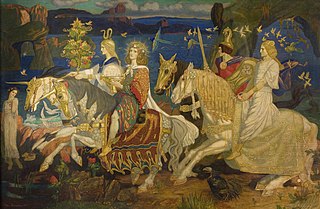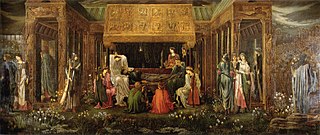Related Research Articles

Christian mythology is the body of myths associated with Christianity. The term encompasses a broad variety of legends and narratives, especially those considered sacred narratives. Mythological themes and elements occur throughout Christian literature, including recurring myths such as ascending a mountain, the axis mundi, myths of combat, descent into the Underworld, accounts of a dying-and-rising god, a flood myth, stories about the founding of a tribe or city, and myths about great heroes of the past, paradises, and self-sacrifice.

Irish mythology is the body of myths indigenous to the island of Ireland. It was originally passed down orally in the prehistoric era. In the early medieval era, some myths were transcribed by Christian monks, who heavily altered and Christianised the myths. Irish mythology is the best-preserved branch of Celtic mythology.

Barlaam and Josaphat, also known as Bilawhar and Budhasaf, are Christian saints. Their life story was based on the life of the Gautama Buddha, and tells of the conversion of Josaphat to Christianity. According to the legend, an Indian king persecuted the Christian Church in his realm. After astrologers predicted that his own son would some day become a Christian, the king imprisoned the young prince Josaphat, who nevertheless met the hermit Saint Barlaam and converted to Christianity. After much tribulation the young prince's father accepted the Christian faith, turned over his throne to Josaphat, and retired to the desert to become a hermit. Josaphat himself later abdicated and went into seclusion with his old teacher Barlaam.

Merlin is a mythical figure prominently featured in the legend of King Arthur and best known as a magician, with several other main roles. The familiar depiction of Merlin, based on an amalgamation of historic and legendary figures, was introduced by the 12th-century British pseudo-historical author Geoffrey of Monmouth and then built on by the French poet Robert de Boron and their prose successors in the 13th century.

The European dragon is a legendary creature in folklore and mythology among the overlapping cultures of Europe.

Avalon is a mythical island featured in the Arthurian legend. It first appeared in Geoffrey of Monmouth's 1136 Historia Regum Britanniae as a place of magic where King Arthur's sword Excalibur was made and later where Arthur was taken to recover from being gravely wounded at the Battle of Camlann. Since then, the island has become a symbol of Arthurian mythology, similar to Arthur's castle of Camelot.
Bogomilism was a Christian neo-Gnostic, dualist sect founded in the First Bulgarian Empire by the priest Bogomil during the reign of Tsar Peter I in the 10th century. It most probably arose in the region of Kutmichevitsa, today part of the region of Macedonia.

The Golden Legend is a collection of 153 hagiographies by Jacobus de Voragine that was widely read in Europe during the Late Middle Ages. More than a thousand manuscripts of the text have survived. It was likely compiled around 1259–1266, although the text was added to over the centuries.

The True Cross is said to be the real cross that Jesus of Nazareth was crucified on, according to Christian tradition.

The Matter of Britain is the body of medieval literature and legendary material associated with Great Britain and Brittany and the legendary kings and heroes associated with it, particularly King Arthur. The 12th-century Welsh cleric Geoffrey of Monmouth's Historia Regum Britanniae, widely popular in its day, is a central component of the Matter of Britain.

The Bosnian Church was a Christian church in medieval Bosnia and Herzegovina that was independent of and considered heretical by both the Catholic and the Eastern Orthodox hierarchies, but in reality, schismatic.
The Second Book of Enoch is a pseudepigraphic text in the apocalyptic genre. It describes the ascent of the patriarch Enoch, ancestor of Noah, through ten heavens of an Earth-centered cosmos. The Slavonic edition and translation of 2 Enoch is of Christian origin in the 8th century but is based on an earlier work. 2 Enoch is distinct from the Book of Enoch, known as 1 Enoch, and there is also an unrelated 3 Enoch, although none of the three books are considered canonical scripture by the majority of Jewish or Christian bodies. The numbering of these texts has been applied by scholars to distinguish each from the others.

The Alexander Romance is an account of the life and exploits of Alexander the Great. Although constructed around an historical core, the romance is mostly fictional. It was widely copied and translated, accruing various legends and fantastical elements at different stages. The original version was composed in Ancient Greek some time before 338 CE, when a Latin translation was made, although the exact date is unknown. Several late manuscripts attribute the work to Alexander's court historian Callisthenes, but Callisthenes died before Alexander and therefore could not have written a full account of his life. The unknown author is still sometimes known as Pseudo-Callisthenes.

Celtic literature is the body of literature written in one of the Celtic languages, or else it may popularly refer to literature written in other languages which is based on the traditional narratives found in early Celtic literature.
The Qiṣaṣ al-anbiyāʾ or Stories of the Prophets is any of various collections of stories about figures recognised as prophets and messengers in Islam, closely related to tafsir.
Bahira is the name of a Christian monk in Islamic traditions who is said to have foretold Muhammad's prophethood when they met while Muhammad was accompanying his uncle Abu Talib on a trading journey. His name derives from the Syriac word bḥīrā, typically used in that language to describe or address a monk, meaning "tested and approved", and is not a proper name.
The Legend of the Rood is a complex of medieval tales loosely derived from the Old Testament.

The Tarnovo Literary School of the late 14th and 15th century was a major medieval Bulgarian cultural academy with important contribution to the Medieval Bulgarian literature established in the capital of Bulgaria Tarnovo. It was part of the Tarnovo School of Art which was characteristic for the culture of the Second Bulgarian Empire.
Jeremiah was a 10th-century Bulgarian priest and writer usually associated with the origins of Bogomilism. The earliest mention of him is found in a work of Patriarch Sisinnius II of Constantinople. He is sometimes associated with, though more often distinguished from, the priest Bogomil.
The Slavic creation myth is a cosmogonic myth in Slavic mythology that explains how the world was created, who created it, and what principles guide it. This myth, in its Christianized form, survived until the nineteenth and twentieth century in various parts of the Slavdom in chronicles or folklore. In the Slavic mythology there are three versions of this myth: the first version is the so-called earth-diver myth, which intertwines two main motifs: the dualistic motif – the cooperation of God and the Devil is required to create the world, and the oceanic motif – the pre-existence water, where the seed of the Earth comes from; the second version speaks about the origin of the universe and the world from the Cosmic Egg and the World Tree; the third one about creation from a dismemberment of a primordial being.
References
- ↑ Andreev, Jordan Kirov; Lazarov, Ivan Kostadinov; Pavlov, Plamen, eds. (1999). Koj koj e v srednovekovna Bălgarija (2., dop. izd ed.). Sofija: Izdat. Kăšta Petăr Beron. ISBN 978-954-402-047-7.
- 1 2 Popovich, Thomas S. (1994). Jeremija the Presbyter and his role in medieval Slavic literature (Thesis). OCLC 34755069.[ page needed ]
- 1 2 "ПОВЕСТ ЗА КРЪСТНОТО ДЪРВО - [PDF Document]". vdocuments.mx (in Bulgarian). Retrieved 2024-02-09.
- ↑ Alvarez, Sandra (2011-12-12). "Bogomilism: An Important Precursor of the Reformation". Medievalists.net. Retrieved 2024-03-09.
- ↑ Brocket, L.P. (1879). The Bogomils of Bulgaria and Bosnia: The Early Protestants of the East.
- ↑ Baring-Gould, Sabine (1868). Curious Myths of the Middle Ages. Vol. 2. Rivingtons. p. 114.